Connectedness of Agricultural Commodities Under Climate Stress: Evidence from a TVP-VAR Approach
Abstract
1. Introduction
2. Literature Review and Research Framing
2.1. Historiograph
2.2. Thematic Map
2.3. Research Questions and Hypotheses
- RQ1: Do external sources of uncertainty—such as climate policy, financial volatility, and geopolitical risk—dominate the connectedness structure of agricultural commodity markets under climate stress?
- RQ2: How does the intensity of connectedness vary across different market states (e.g., normal vs. extreme conditions)?
- RQ3: What is the specific role of climate policy uncertainty (CPU) in the propagation of systemic risk across agri-food markets?
3. Empirical Data and Methodological Approach
3.1. The Data
3.2. Time-Varying Parameter Vector Autoregressive (TVP-VAR) Model
- To others:
- From others:
- Net connectedness:
4. Empirical Findings
4.1. General Connectedness Results
4.2. Internal and External Connectedness Findings
4.2.1. Dynamic Total Connectedness Index (TCI)
4.2.2. Net Total Directional Connectedness
4.2.3. Total Directional Connectedness Received from External and Internal Spillovers
4.2.4. Total Directional Connectedness Transmitted to Other Economies: External and Internal Spillovers
4.2.5. Internal Net Pairwise Total Directional Connectedness
4.2.6. External Net Pairwise Total Directional Connectedness
5. Discussion
6. Conclusions
6.1. Contribution and Conceptual Innovation
6.2. Principal Findings
6.3. Interpretation of Crisis Effects
6.4. Limitations and Future Research Directions
6.5. Policy Implications and Final Remarks
Author Contributions
Funding
Institutional Review Board Statement
Informed Consent Statement
Data Availability Statement
Acknowledgments
Conflicts of Interest
References
- Khalfaoui, R.; Goodell, J.W.; Mefteh-Wali, S.; Chishti, M.Z.; Gozgor, G. Impact of Climate Risk Shocks on Global Food and Agricultural Markets: A Multiscale and Tail Connectedness Analysis. Int. Rev. Financ. Anal. 2024, 93, 103206. [Google Scholar] [CrossRef]
- Le, T.H.; Pham, L.; Do, H.X. Price Risk Transmissions in the Water-Energy-Food Nexus: Impacts of Climate Risks and Portfolio Implications. Energy Econ. 2023, 124, 106787. [Google Scholar] [CrossRef]
- Mao, X.; Wei, P.; Ren, X. Climate Risk and Financial Systems: A Nonlinear Network Connectedness Analysis. J. Environ. Manag. 2023, 340, 117878. [Google Scholar] [CrossRef]
- Coskun, M.; Khan, N.; Saleem, A.; Hammoudeh, S. Spillover Connectedness Nexus Geopolitical Oil Price Risk, Clean Energy Stocks, Global Stock, and Commodity Markets. J. Clean. Prod. 2023, 429, 139583. [Google Scholar] [CrossRef]
- Ghosh, B.; Ghosh, A. Change in Dietary Pattern of Agri Commodities in the Past Six Decades: Time-Varying VAR Approach. Glob. Food Secur. 2025, 44, 100823. [Google Scholar] [CrossRef]
- Xue, H.; Du, Y.; Gao, Y.; Su, W.-H. Spatial Price Transmission and Dynamic Volatility Spillovers in the Global Grain Markets: A TVP-VAR-Connectedness Approach. Foods 2024, 13, 3317. [Google Scholar] [CrossRef]
- Mubenga-Tshitaka, J.-L.; Muteba Mwamba, J.W.; Dikgang, J.; Gelo, D. Risk Spillover between Climate Variables and the Agricultural Commodity Market in East Africa. Clim. Risk Manag. 2023, 42, 100561. [Google Scholar] [CrossRef]
- Chen, M.; Xiao, H.; Zhao, H.; Liu, L. The Power of Attention: Government Climate-Risk Attention and Agricultural-Land Carbon Emissions. Environ. Res. 2024, 251, 118661. [Google Scholar] [CrossRef]
- Zeng, H.; Xu, W.; Lu, R. Quantile Frequency Connectedness between Crude Oil Volatility, Geopolitical Risk and Major Agriculture and Livestock Markets. Appl. Econ. 2025, 57, 3345–3360. [Google Scholar] [CrossRef]
- Tiwari, A.K.; Abakah, E.J.A.; Adewuyi, A.O.; Lee, C.-C. Quantile Risk Spillovers between Energy and Agricultural Commodity Markets: Evidence from Pre and during COVID-19 Outbreak. Energy Econ. 2022, 113, 106235. [Google Scholar] [CrossRef]
- Li, Y.; Chen, S.; Sensoy, A.; Wang, L. Over-Expected Shocks and Financial Market Security: Evidence from China’s Markets. Res. Int. Bus. Financ. 2024, 68, 102194. [Google Scholar] [CrossRef]
- Iqbal, N.; Bouri, E.; Grebinevych, O.; Roubaud, D. Modelling Extreme Risk Spillovers in the Commodity Markets around Crisis Periods Including COVID-19. Ann. Oper. Res. 2023, 330, 305–334. [Google Scholar] [CrossRef]
- Dai, Z.; Zhu, H. Dynamic Risk Spillover among Crude Oil, Economic Policy Uncertainty and Chinese Financial Sectors. Int. Rev. Econ. Financ. 2023, 83, 421–450. [Google Scholar] [CrossRef]
- Yousfi, M.; Bouzgarrou, H. Quantile Time–Frequency Connectedness between Energy and Agriculture Markets: A Study during the COVID-19 Crisis and the Russo–FUkrainian Conflict. J. Financ. Econ. Policy 2024, 16, 559–579. [Google Scholar] [CrossRef]
- Yan, W.-L.; Cheung, A.; Wai, K. Quantile Connectedness among Climate Policy Uncertainty, News Sentiment, Oil and Renewables in China. Res. Int. Bus. Financ. 2025, 76, 102814. [Google Scholar] [CrossRef]
- Wu, G.; Hu, G. Asymmetric Spillovers and Resilience in Physical and Financial Assets amid Climate Policy Uncertainties: Evidence from China. Technol. Forecast. Soc. Change 2024, 208, 123701. [Google Scholar] [CrossRef]
- Caporin, M.; Naeem, M.A.; Arif, M.; Hasan, M.; Vo, X.V.; Hussain Shahzad, S.J. Asymmetric and Time-Frequency Spillovers among Commodities Using High-Frequency Data. Resour. Policy 2021, 70, 101958. [Google Scholar] [CrossRef]
- Balli, F.; Naeem, M.A.; Shahzad, S.J.H.; de Bruin, A. Spillover Network of Commodity Uncertainties. Energy Econ. 2019, 81, 914–927. [Google Scholar] [CrossRef]
- Pham, L.; Kamal, J. Bin Blessings or Curse: How Do Media Climate Change Concerns Affect Commodity Tail Risk Spillovers? J. Commod. Mark. 2024, 34, 100407. [Google Scholar] [CrossRef]
- Lucey, B.; Ren, B. Time-Varying Tail Risk Connectedness among Sustainability-Related Products and Fossil Energy Investments. Energy Econ. 2023, 126, 106812. [Google Scholar] [CrossRef]
- Wang, K.-H.; Kan, J.-M.; Qiu, L.; Xu, S. Climate Policy Uncertainty, Oil Price and Agricultural Commodity: From Quantile and Time Perspective. Econ. Anal. Policy 2023, 78, 256–272. [Google Scholar] [CrossRef]
- Zeng, H.; Abedin, M.Z.; Ahmed, A.D.; Lucey, B. Quantile and Time–Frequency Risk Spillover Between Climate Policy Uncertainty and Grains Commodity Markets. J. Futures Mark. 2025, 45, 659–682. [Google Scholar] [CrossRef]
- Ren, Y.; Wang, N.; Zhu, H. Dynamic Connectedness of Climate Risks, Oil Shocks, and China’s Energy Futures Market: Time-Frequency Evidence from Quantile-on-Quantile Regression. N. Am. J. Econ. Financ. 2025, 75, 102263. [Google Scholar] [CrossRef]
- Zeng, H.; Lu, R.; Ahmed, A.D. Return Connectedness and Multiscale Spillovers across Clean Energy Indices and Grain Commodity Markets around COVID-19 Crisis. J. Environ. Manag. 2023, 340, 117912. [Google Scholar] [CrossRef]
- Tan, X.; Wang, X.; Ma, S.; Wang, Z.; Zhao, Y.; Xiang, L. COVID-19 Shock and the Time-Varying Volatility Spillovers Among the Energy and Precious Metals Markets: Evidence From A DCC-GARCH-Connectedness Approach. Front. Public Health 2022, 10, 906969. [Google Scholar] [CrossRef] [PubMed]
- Jiang, W.; Chen, Y. Impact of Russia-Ukraine Conflict on the Time-Frequency and Quantile Connectedness between Energy, Metal and Agricultural Markets. Resour. Policy 2024, 88, 104376. [Google Scholar] [CrossRef]
- Ghosh, B.; Paparas, D. Quantile Connectedness in Agri-Commodity Markets: What Has Changed over Past Six Decades? Heliyon 2023, 9, e13463. [Google Scholar] [CrossRef]
- Jiang, Y.; Ao, Z.; Mo, B. The Risk Spillover between China’s Economic Policy Uncertainty and Commodity Markets: Evidence from Frequency Spillover and Quantile Connectedness Approaches. N. Am. J. Econ. Financ. 2023, 66, 101905. [Google Scholar] [CrossRef]
- Polat, O.; Doğan Başar, B.; Torun, E.; Ekşi, İ.H. Dynamic Interlinkages between Geopolitical Stress and Agricultural Commodity Market: Novel Findings in the Wake of the Russian Ukrainian Conflict. Borsa Istanb. Rev. 2023, 23, S74–S83. [Google Scholar] [CrossRef]
- Karkowska, R.; Urjasz, S. Importance of Geopolitical Risk in Volatility Structure: New Evidence from Biofuels, Crude Oil, and Grains Commodity Markets. J. Commod. Mark. 2024, 36, 100440. [Google Scholar] [CrossRef]
- Ge, J.; Min Du, A.; Lin, B. Volatility in a Mug Cup: Spillovers among Cocoa, Coffee, Sugar Futures and the Role of Climate Policy Risk. Res. Int. Bus. Financ. 2025, 73, 102634. [Google Scholar] [CrossRef]
- Baker, S.R.; Bloom, N.; Davis, S.J. Measuring Economic Policy Uncertainty. Q. J. Econ. 2016, 131, 1593–1636. [Google Scholar] [CrossRef]
- Jurado, K.; Ludvigson, S.C.; Ng, S. Measuring Uncertainty. Am. Econ. Rev. 2015, 105, 1177–1216. [Google Scholar] [CrossRef]
- Caldara, D.; Iacoviello, M. Measuring Geopolitical Risk. Am. Econ. Rev. 2022, 112, 1194–1225. [Google Scholar] [CrossRef]
- Whaley, R.E. Understanding the VIX. J. Portf. Manag. 2009, 35, 98–105. [Google Scholar] [CrossRef]
- Cochrane, J.H. Monetary Policy with Interest on Reserves. J. Econ. Dyn. Control. 2014, 49, 74–108. [Google Scholar] [CrossRef]
- Adekoya, O.B.; Oliyide, J.A. How COVID-19 Drives Connectedness among Commodity and Financial Markets: Evidence from TVP-VAR and Causality-in-Quantiles Techniques. Resour. Policy 2021, 70, 101898. [Google Scholar] [CrossRef] [PubMed]
- Wu, Y.; Ren, W.; Wan, J.; Liu, X. Time-Frequency Volatility Connectedness between Fossil Energy and Agricultural Commodities: Comparing the COVID-19 Pandemic with the Russia-Ukraine Conflict. Financ. Res. Lett. 2023, 55, 103866. [Google Scholar] [CrossRef]
- Zhou, X.; Enilov, M.; Parhi, M. Does Oil Spin the Commodity Wheel? Quantile Connectedness with a Common Factor Error Structure across Energy and Agricultural Markets. Energy Econ. 2024, 132, 107468. [Google Scholar] [CrossRef]
- Mensi, W.; Hammoudeh, S.; Kang, S.H. Precious Metals, Cereal, Oil and Stock Market Linkages and Portfolio Risk Management: Evidence from Saudi Arabia. Econ. Model. 2015, 51, 340–358. [Google Scholar] [CrossRef]
- Algieri, B.; Leccadito, A. Assessing Contagion Risk from Energy and Non-Energy Commodity Markets. Energy Econ. 2017, 62, 312–322. [Google Scholar] [CrossRef]
- Mensi, W.; Hammoudeh, S.; Al-Jarrah, I.M.W.; Sensoy, A.; Kang, S.H. Dynamic Risk Spillovers between Gold, Oil Prices and Conventional, Sustainability and Islamic Equity Aggregates and Sectors with Portfolio Implications. Energy Econ. 2017, 67, 454–475. [Google Scholar] [CrossRef]
- Ji, Q.; Bouri, E.; Roubaud, D.; Shahzad, S.J.H. Risk Spillover between Energy and Agricultural Commodity Markets: A Dependence-Switching CoVaR-Copula Model. Energy Econ. 2018, 75, 14–27. [Google Scholar] [CrossRef]
- Aria, M.; Cuccurullo, C. Bibliometrix: An R-Tool for Comprehensive Science Mapping Analysis. J. Informetr. 2017, 11, 959–975. [Google Scholar] [CrossRef]
- Ferrer, R.; Shahzad, S.J.H.; López, R.; Jareño, F. Time and Frequency Dynamics of Connectedness between Renewable Energy Stocks and Crude Oil Prices. Energy Econ. 2018, 76, 1–20. [Google Scholar] [CrossRef]
- Yahya, M.; Oglend, A.; Dahl, R.E. Temporal and Spectral Dependence between Crude Oil and Agricultural Commodities: A Wavelet-Based Copula Approach. Energy Econ. 2019, 80, 277–296. [Google Scholar] [CrossRef]
- Meng, J.; Nie, H.; Mo, B.; Jiang, Y. Risk Spillover Effects from Global Crude Oil Market to China’s Commodity Sectors. Energy 2020, 202, 117208. [Google Scholar] [CrossRef]
- Bouri, E.; Lucey, B.; Saeed, T.; Vo, X.V. The Realized Volatility of Commodity Futures: Interconnectedness and Determinants. Int. Rev. Econ. Financ. 2021, 73, 139–151. [Google Scholar] [CrossRef]
- Mensi, W.; Shafiullah, M.; Vo, X.V.; Kang, S.H. Volatility Spillovers between Strategic Commodity Futures and Stock Markets and Portfolio Implications: Evidence from Developed and Emerging Economies. Resour. Policy 2021, 71, 102002. [Google Scholar] [CrossRef]
- Bouri, E.; Lei, X.; Jalkh, N.; Xu, Y.; Zhang, H. Spillovers in Higher Moments and Jumps across US Stock and Strategic Commodity Markets. Resour. Policy 2021, 72, 102060. [Google Scholar] [CrossRef]
- Mensi, W.; Al Rababa’a, A.R.; Vo, X.V.; Kang, S.H. Asymmetric Spillover and Network Connectedness between Crude Oil, Gold, and Chinese Sector Stock Markets. Energy Econ. 2021, 98, 105262. [Google Scholar] [CrossRef]
- Umar, Z.; Jareño, F.; Escribano, A. Agricultural Commodity Markets and Oil Prices: An Analysis of the Dynamic Return and Volatility Connectedness. Resour. Policy 2021, 73, 102147. [Google Scholar] [CrossRef]
- Mensi, W.; Yousaf, I.; Vo, X.V.; Kang, S.H. Asymmetric Spillover and Network Connectedness between Gold, BRENT Oil and EU Subsector Markets. J. Int. Financ. Mark. Inst. Money 2022, 76, 101487. [Google Scholar] [CrossRef]
- Balcilar, M.; Gabauer, D.; Umar, Z. Crude Oil Futures Contracts and Commodity Markets: New Evidence from a TVP-VAR Extended Joint Connectedness Approach. Resour. Policy 2021, 73, 102219. [Google Scholar] [CrossRef]
- Gavriilidis, K. Measuring Climate Policy Uncertainty. 2021. Available online: https://papers.ssrn.com/sol3/papers.cfm?abstract_id=3847388 (accessed on 30 May 2025).
- Antonakakis, N.; Gabauer, D. Refined Measures of Dynamic Connectedness Based on TVP-VAR. MPRA Pap. 2017, 78282. [Google Scholar]
- Antonakakis, N.; Gabauer, D.; Gupta, R.; Plakandaras, V. Dynamic Connectedness of Uncertainty across Developed Economies: A Time-Varying Approach. Econ. Lett. 2018, 166, 63–75. [Google Scholar] [CrossRef]
- Diebold, F.X.; Yilmaz, K. Measuring Financial Asset Return and Volatility Spillovers, with Application to Global Equity Markets. Econ. J. 2009, 119, 158–171. [Google Scholar] [CrossRef]
- Diebold, F.X.; Yilmaz, K. Better to Give than to Receive: Predictive Directional Measurement of Volatility Spillovers. Int. J. Forecast. 2012, 28, 57–66. [Google Scholar] [CrossRef]
- Koop, G.; Pesaran, M.H.; Potter, S.M. Impulse Response Analysis in Nonlinear Multivariate Models. J. Econom. 1996, 74, 119–147. [Google Scholar] [CrossRef]
- Pesaran, H.H.; Shin, Y. Generalized Impulse Response Analysis in Linear Multivariate Models. Econ. Lett. 1998, 58, 17–29. [Google Scholar] [CrossRef]
- Gao, W.; Wei, J.; Zhang, H.; Zhang, H. Does Climate Policy Uncertainty Exacerbate Extreme Risk Spillovers between Green Economy and Energy Metals? Resour. Policy 2024, 91, 104946. [Google Scholar] [CrossRef]
- Zhang, J.; Zhang, Y.; Wei, Y.; Wang, Z. Normal and Extreme Impact and Connectedness between Fossil Energy Futures Markets and Uncertainties: Does El Niño-Southern Oscillation Matter? Int. Rev. Econ. Financ. 2024, 89, 188–215. [Google Scholar] [CrossRef]
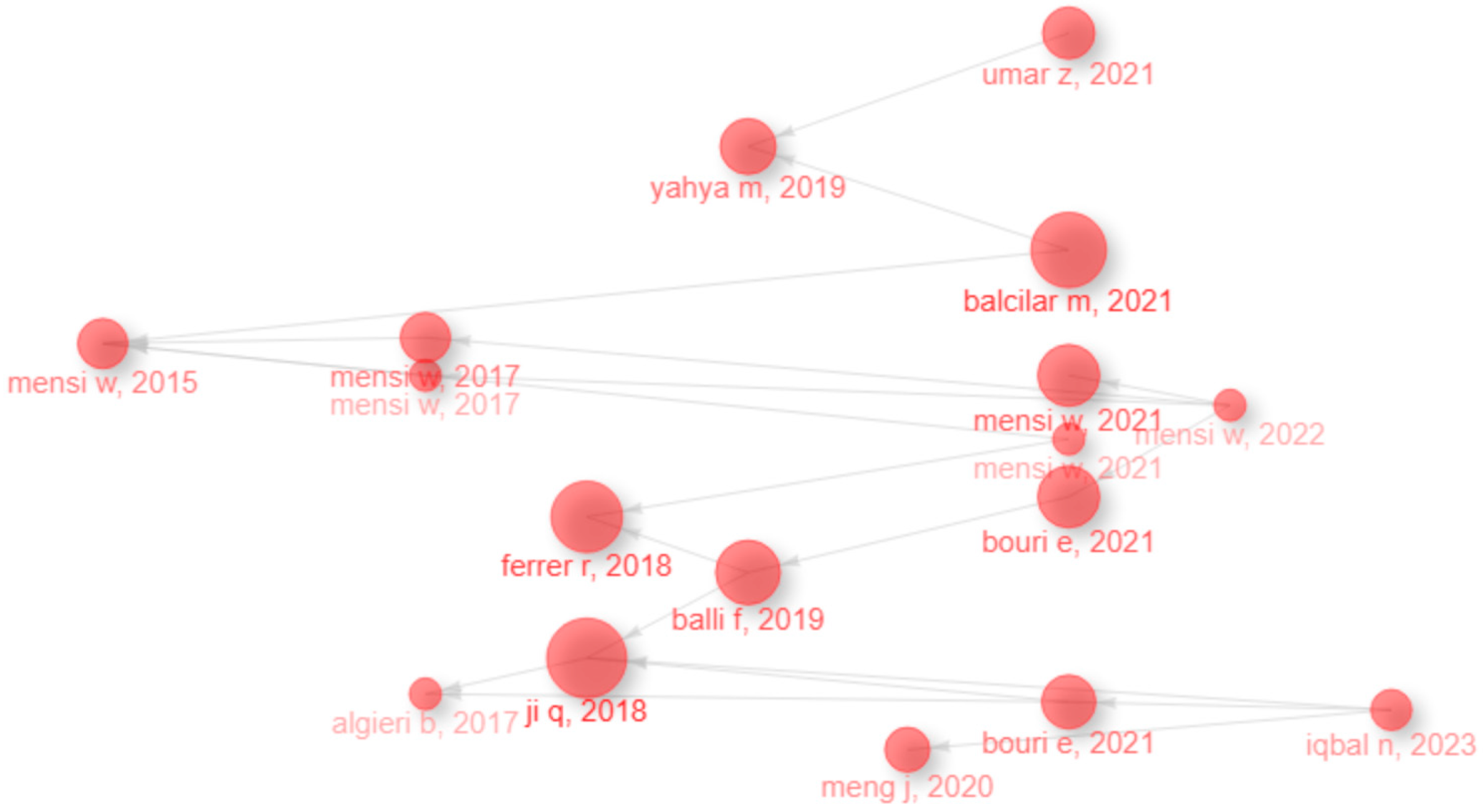
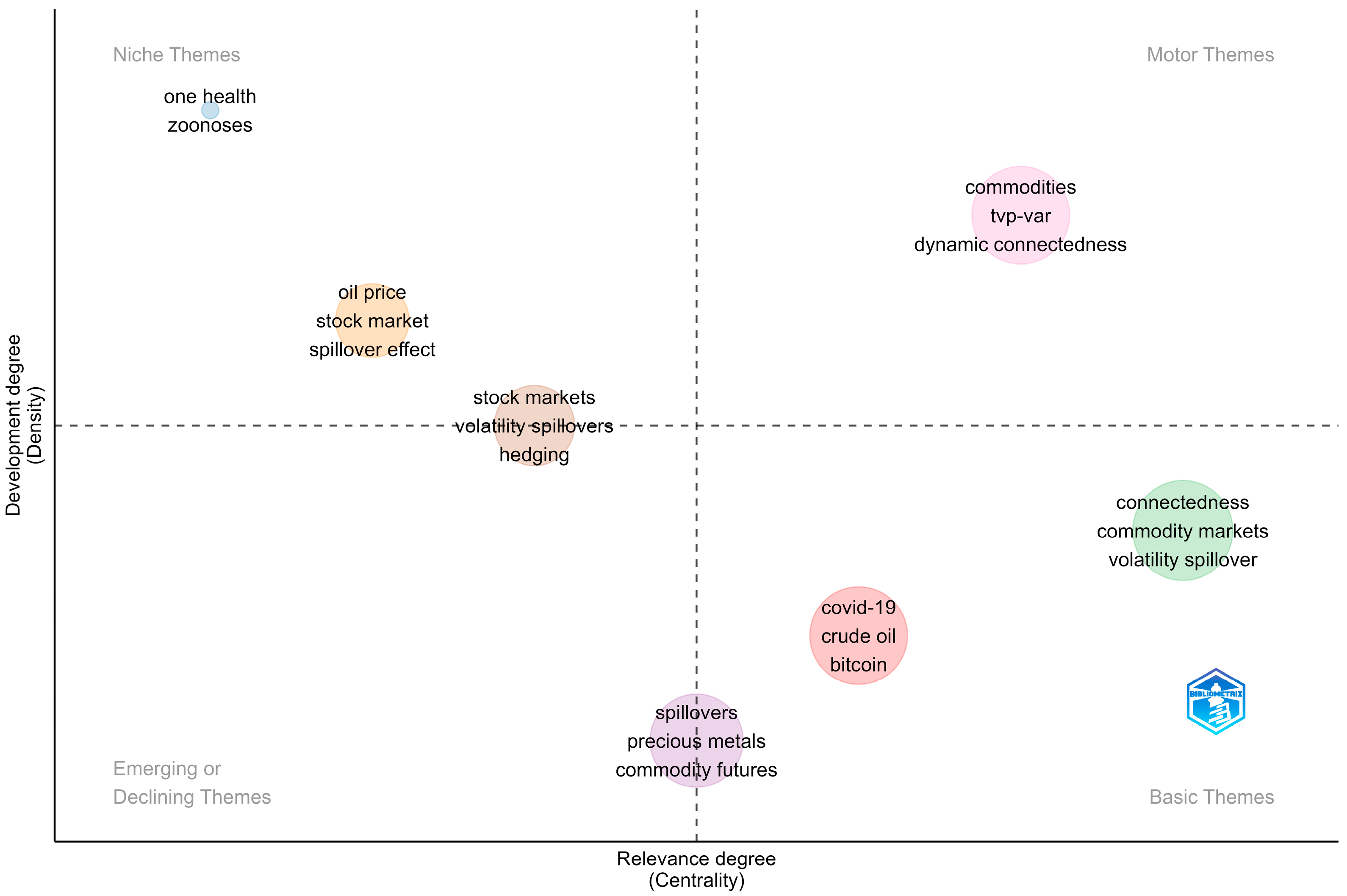

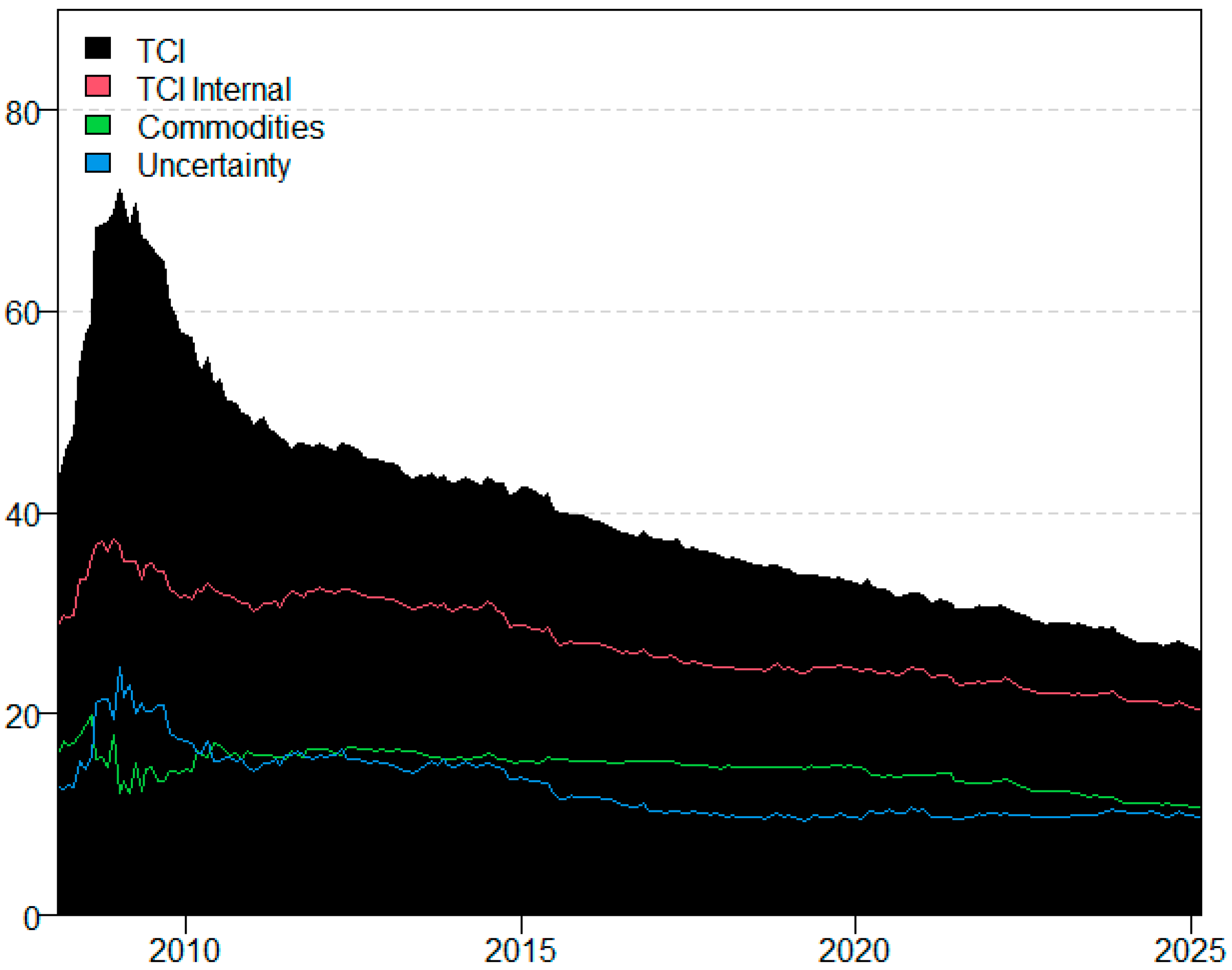
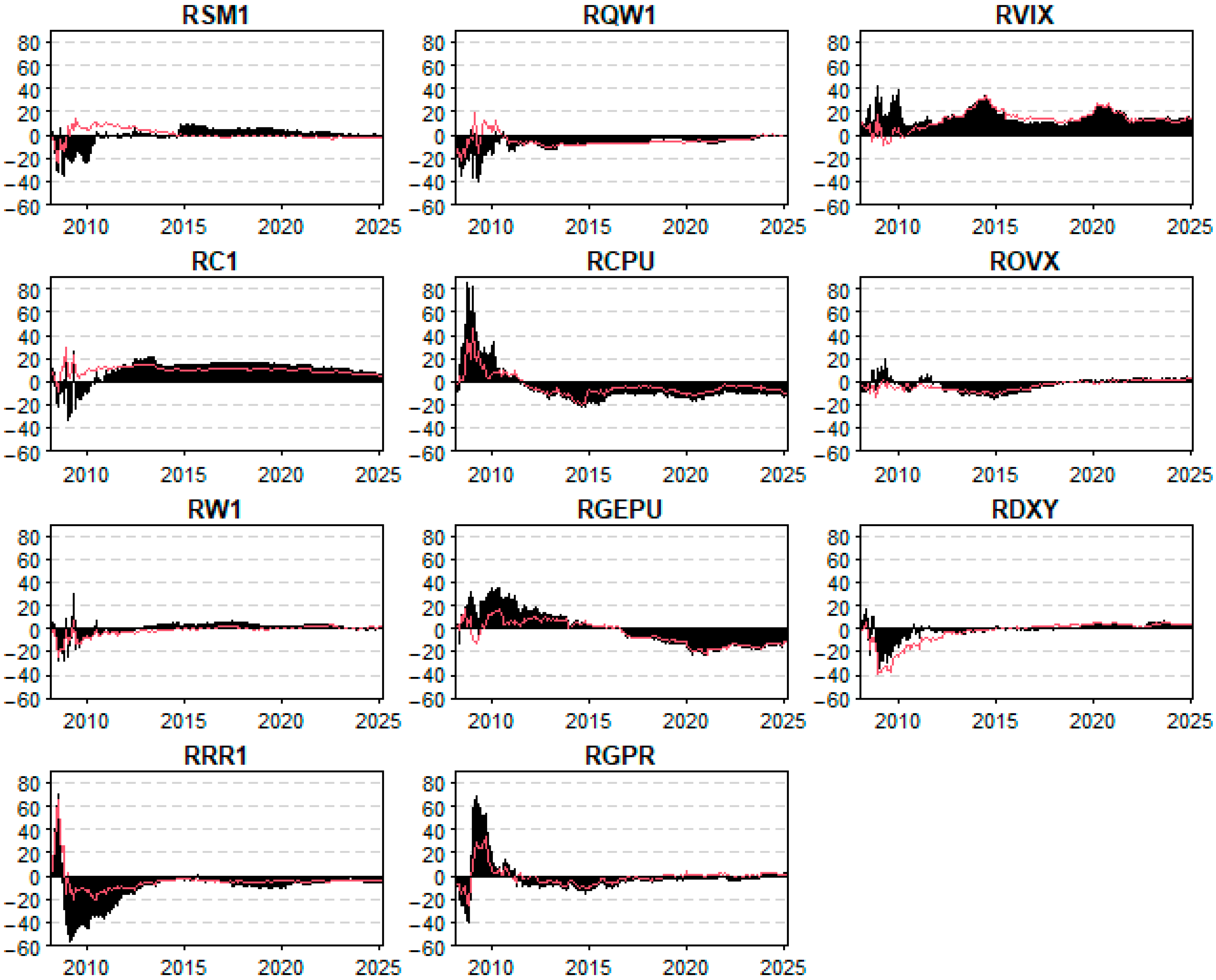

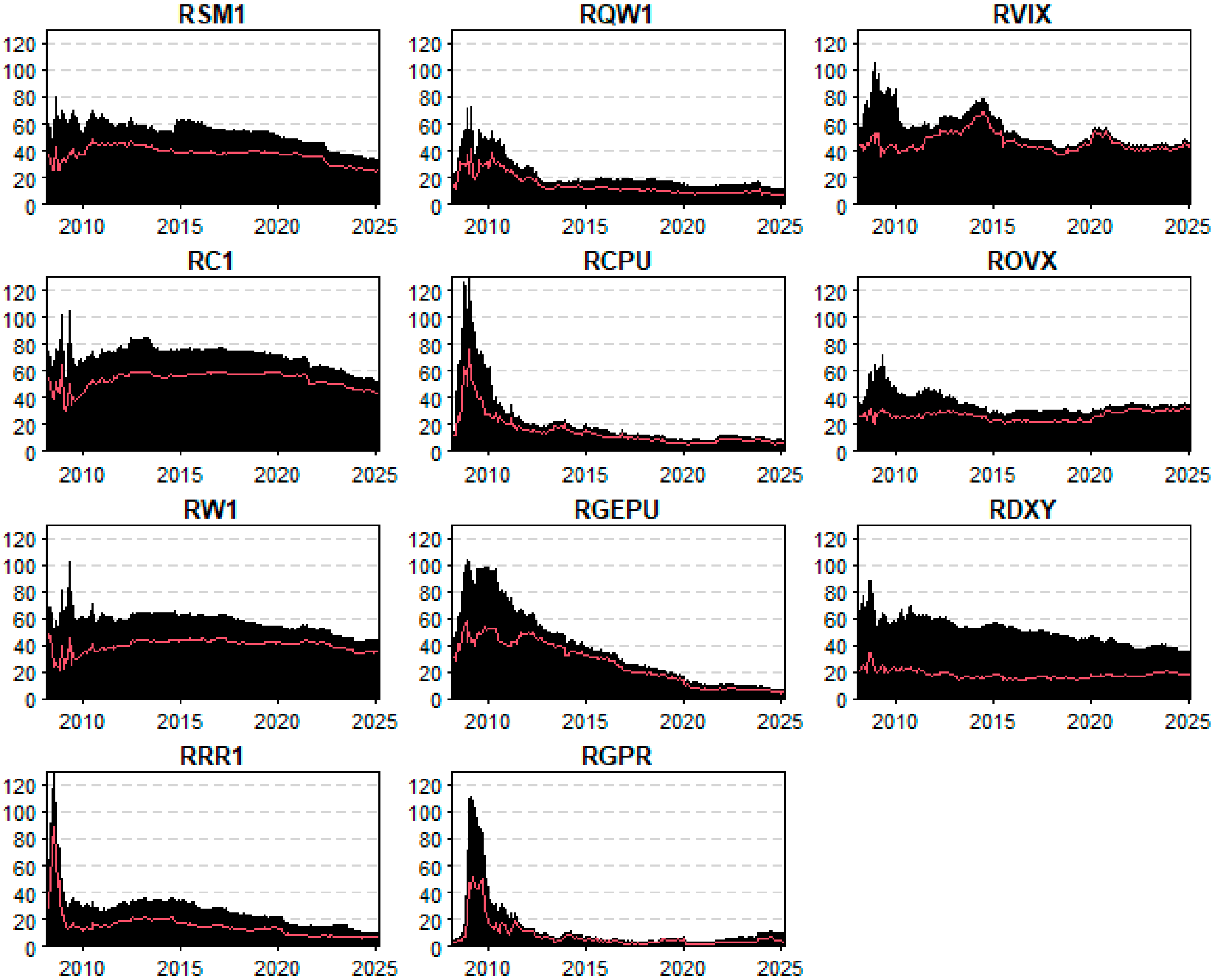
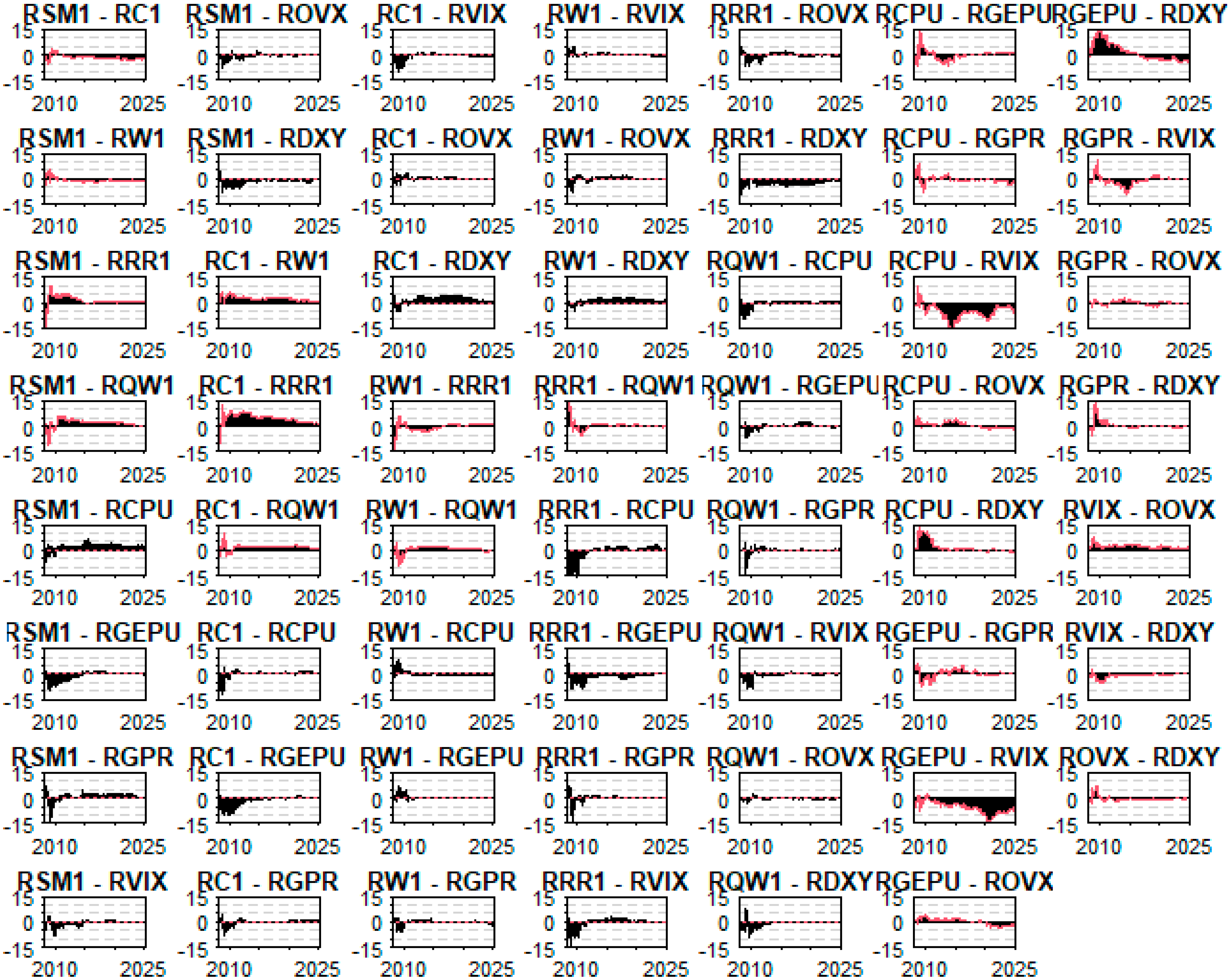
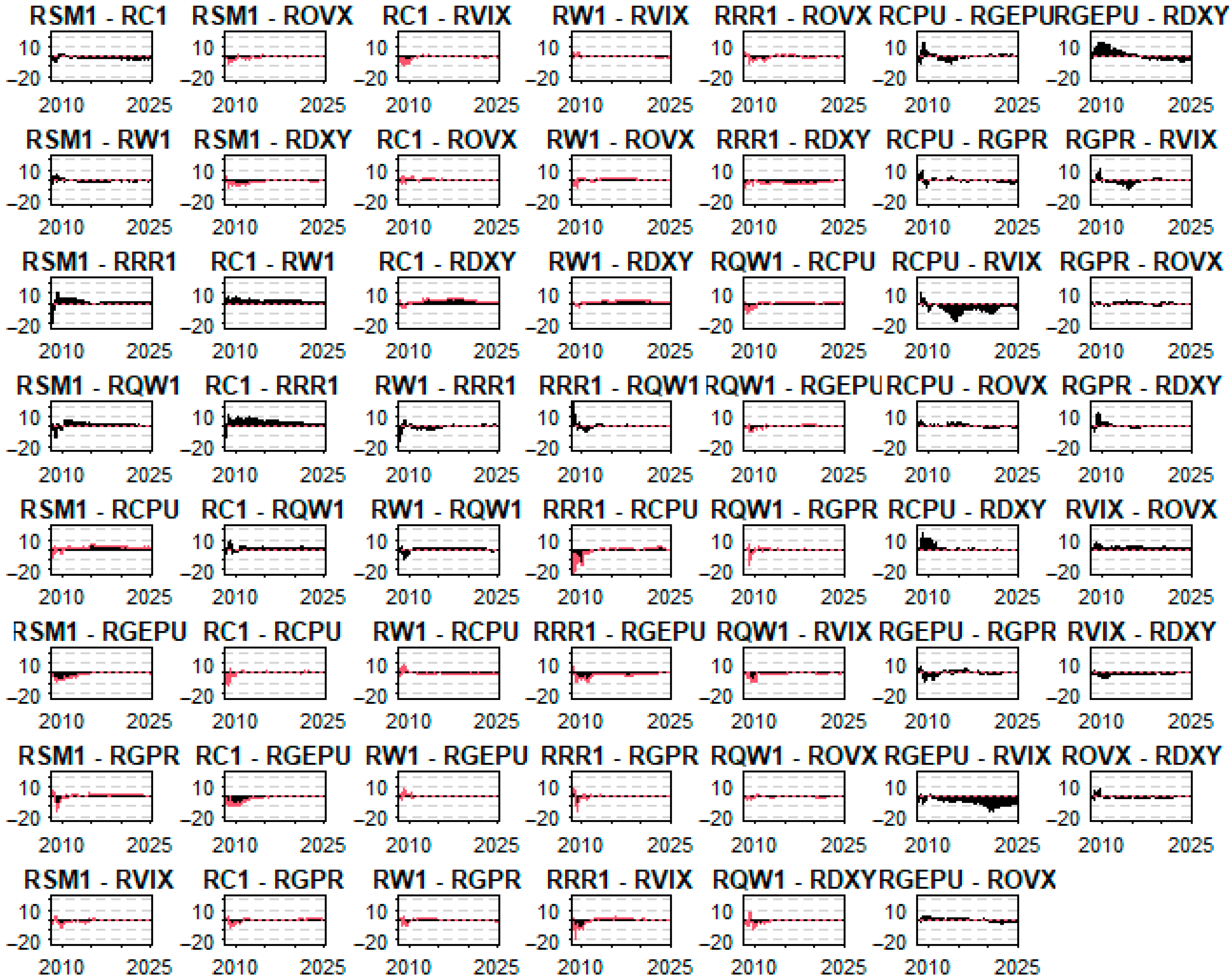
| Variable | Label | Description |
|---|---|---|
| Soybean Meal CBT | SM1 Comdty | Monthly price data for soybean meal, listed under the soybean category (:SOY) on the Chicago Board of Trade (CBT). |
| Corn Meal CBT | C 1 Comdty | Monthly price data for corn meal, categorized as corn (:CORN) and traded on the Chicago Board of Trade (CBT). |
| Wheat Meal CBT | W 1 Comdty | Monthly price data for wheat meal, classified under wheat (:WHET) and listed on the Chicago Board of Trade (CBT). |
| Rough Rice Meal CBT | RR1 Comdty | Monthly price data for rough rice meal, grouped under other grains (:OGRN) and traded on the Chicago Board of Trade (CBT). |
| Sugar LIF | QW1 Comdty | Monthly price data for sugar, identified as part of the foodstuff category (:FOOD) and traded on the NYSE LIFFE exchange in London (LIF). |
| Climate Policy Uncertainty Index | CPU | Developed by [55], the U.S. Climate Policy Uncertainty (CPU) Index measures climate-related policy uncertainty using keyword frequency in eight major U.S. newspapers from April 1987 onward. Following the [32] methodology, article counts are standardized and averaged monthly across sources, then normalized to a mean of 100 over the period from April 1987 to March 2025. |
| Global EPU Index | GEPU | Compiled by [32], the Global Economic Policy Uncertainty (GEPU) Index adjusts national-level indices and interpolates missing observations to produce a GDP-weighted measure of policy uncertainty across 21 countries, representing approximately 71% of global economic activity. |
| Geopolitical Risk Index | GPR | Developed by [34], the Geopolitical Risk Index measures geopolitical tensions based on automated text-search results from leading international newspapers. The index quantifies the frequency of articles related to geopolitical tensions, wars, terrorism, and nuclear threats, providing a real-time measure of global political uncertainty. |
| CBOE Volatility Index | VIX Index | The Chicago Board Options Exchange (CBOE) Volatility Index, commonly known as the “fear gauge,” measures implied volatility of S & P 500 index options. This real-time market index represents investors’ expectations of market volatility over the next 30 days and serves as a key indicator of market sentiment and financial stress conditions. |
| CBOE Crude Oil Volatility Index | OVX Index | The CBOE Crude Oil ETF Volatility Index measures the market’s expectation of 30-day volatility of crude oil prices by applying the VIX methodology to options on the United States Oil Fund (USO). This index captures energy market-specific uncertainty and risk perceptions that significantly influence commodity market dynamics. |
| U.S. Dollar Index | DXY Index | The U.S. Dollar Index measures the value of the United States dollar relative to a basket of foreign currencies, including the euro, Japanese yen, British pound, Canadian dollar, Swedish krona, and Swiss franc. This index serves as a benchmark for the dollar’s strength and significantly influences international commodity pricing dynamics, as most commodities are priced in U.S. dollars. |
| Statistic/Metric | RSM1 | RC1 | RW1 | RRR1 | RQW1 | RCPU | RGEPU | RGPR | RVIX | ROVX | RDXY |
|---|---|---|---|---|---|---|---|---|---|---|---|
| Mean | −0.001 (0.904) | 0.000 (0.942) | −0.003 (0.681) | 0.000 (0.934) | 0.002 (0.672) | 0.008 (0.733) | 0.006 (0.651) | 0.004 (0.785) | −0.001 (0.962) | 0.000 (0.994) | 0.002 (0.315) |
| Variance | 0.008 | 0.008 | 0.009 | 0.005 | 0.005 | 0.126 | 0.037 | 0.038 | 0.055 | 0.039 | 0.001 |
| Skewness | −0.330 * (0.051) | −0.331 ** (0.050) | 0.113 (0.495) | −0.362 ** (0.033) | −0.231 (0.167) | 0.092 (0.579) | 0.376 ** (0.027) | 0.435 ** (0.011) | 0.401 ** (0.019) | 1.283 *** (0.000) | 0.089 (0.590) |
| Ex. Kurtosis | 1.543 *** (0.002) | 1.091 ** (0.012) | 1.059 ** (0.013) | 1.309 *** (0.005) | 0.885 ** (0.028) | 0.292 (0.304) | 0.411 (0.192) | 1.319 *** (0.005) | 0.744 ** (0.050) | 6.649 *** (0.000) | 0.639 * (0.077) |
| JB | 24.175 *** (0.000) | 13.982 *** (0.001) | 10.060 *** (0.007) | 19.222 *** (0.000) | 8.552 ** (0.014) | 1.020 (0.601) | 6.295 ** (0.043) | 21.420 *** (0.000) | 10.283 *** (0.006) | 435.960 *** (0.000) | 3.779 (0.151) |
| ERS | −2.869 (0.005) | −3.037 *** (0.003) | −1.721 * (0.087) | −0.989 (0.324) | −1.933 * (0.055) | −9.443 *** (0.000) | −1.363 (0.175) | −8.928 (0.000) | −7.991 (0.000) | −4.327 (0.000) | −2.978 (0.003) |
| Q (20) | 20.239 ** (0.016) | 15.927 * (0.087) | 17.134 * (0.056) | 9.803 (0.527) | 10.626 (0.439) | 54.885 *** (0.000) | 42.456 *** (0.000) | 23.360 *** (0.004) | 21.536 *** (0.009) | 16.652 * (0.067) | 14.285 (0.155) |
| Q2 (20) | 12.511 (0.268) | 19.120 ** (0.025) | 11.878 (0.320) | 39.485 *** (0.000) | 41.234 *** (0.000) | 19.727 ** (0.019) | 10.522 (0.450) | 13.914 (0.175) | 10.901 (0.411) | 15.931 * (0.087) | 48.197 *** (0.000) |
| RSM1 | RC1 | RW1 | RRR1 | RQW1 | RCPU | RGEPU | RGPR | RVIX | ROVX | RDXY | |
|---|---|---|---|---|---|---|---|---|---|---|---|
| RSM1 | 1.000 | ||||||||||
| RC1 | 0.357 | 1.000 | |||||||||
| RW1 | 0.312 | 0.460 | 1.000 | ||||||||
| RRR1 | 0.145 | 0.224 | 0.199 | 1.000 | |||||||
| RQW1 | 0.093 | 0.107 | 0.089 | 0.053 | 1.000 | ||||||
| RCPU | −0.040 | −0.044 | 0.017 | 0.037 | −0.020 | 1.000 | |||||
| RGEPU | −0.034 | −0.051 | 0.014 | 0.052 | −0.074 | 0.163 | 1.000 | ||||
| RGPR | 0.046 | 0.067 | 0.038 | 0.001 | 0.012 | −0.030 | −0.018 | 1.000 | |||
| RVIX | −0.082 | −0.041 | −0.069 | −0.018 | −0.044 | −0.001 | −0.003 | 0.074 | 1.000 | ||
| ROVX | −0.043 | −0.007 | 0.011 | 0.052 | −0.070 | 0.008 | 0.056 | 0.051 | 0.313 | 1.000 | |
| RDXY | −0.144 | −0.174 | −0.215 | −0.117 | −0.136 | −0.030 | 0.000 | 0.035 | 0.228 | 0.190 | 1.000 |
| RSM1 | RC1 | RW1 | RRR1 | RQW1 | RCPU | RGEPU | RGPR | RVIX | ROVX | RDXY | FROM | |
|---|---|---|---|---|---|---|---|---|---|---|---|---|
| RSM1 | 46.89 | 16.45 | 12.28 | 1.89 | 6.20 | 1.44 | 3.10 | 1.14 | 2.54 | 1.87 | 6.20 | 53.11 |
| RC1 | 14.97 | 39.98 | 18.85 | 6.06 | 3.44 | 1.17 | 2.96 | 1.09 | 2.42 | 1.01 | 8.07 | 60.02 |
| RW1 | 11.41 | 21.21 | 43.75 | 5.37 | 3.24 | 0.84 | 0.87 | 1.21 | 1.68 | 1.53 | 8.89 | 56.25 |
| RRR1 | 2.96 | 10.69 | 4.91 | 63.04 | 1.33 | 2.48 | 2.89 | 1.02 | 1.82 | 2.14 | 6.74 | 36.96 |
| RQW1 | 8.09 | 5.19 | 3.93 | 2.00 | 71.35 | 0.99 | 1.39 | 1.21 | 1.03 | 2.52 | 2.29 | 28.65 |
| RCPU | 3.57 | 1.45 | 1.02 | 1.76 | 0.58 | 73.35 | 5.98 | 2.07 | 7.80 | 1.53 | 0.88 | 26.65 |
| RGEPU | 2.35 | 1.40 | 1.22 | 1.47 | 1.48 | 6.13 | 62.39 | 2.25 | 13.61 | 3.65 | 4.04 | 37.61 |
| RGPR | 2.02 | 0.92 | 1.09 | 1.01 | 1.17 | 1.59 | 2.81 | 85.35 | 2.09 | 1.12 | 0.84 | 14.65 |
| RVIX | 1.84 | 1.90 | 1.91 | 1.45 | 0.64 | 2.24 | 7.94 | 1.13 | 59.61 | 14.90 | 6.45 | 40.39 |
| ROVX | 1.22 | 1.30 | 1.81 | 1.79 | 2.24 | 2.25 | 3.68 | 0.91 | 17.08 | 61.77 | 5.96 | 38.23 |
| RDXY | 4.54 | 10.07 | 10.17 | 4.06 | 1.37 | 2.47 | 5.51 | 1.34 | 5.84 | 5.63 | 49.00 | 51.00 |
| TO | 52.96 | 70.60 | 57.18 | 26.87 | 21.69 | 21.61 | 37.11 | 13.37 | 55.91 | 35.89 | 50.34 | 443.54 |
| Inc. Own | 99.85 | 110.58 | 100.92 | 89.91 | 93.04 | 94.96 | 99.50 | 98.72 | 115.52 | 97.66 | 99.34 | cTCI/TCI |
| NET | −0.15 | 10.58 | 0.92 | −10.09 | −6.96 | −5.04 | −0.50 | −1.28 | 15.52 | −2.34 | −0.66 | 44.35/40.32 |
| NPT | 4 | 7 | 7 | 2 | 1 | 5 | 6 | 6 | 8 | 4 | 5 |
| Originating Variable (Shock Transmitter) | Receiving Variable (Shock Receiver) | Direction (→) | Average Spillover Magnitude (%) | Net Transmitter/Receiver | Interpretation |
|---|---|---|---|---|---|
| RVIX (Financial Volatility Index) | Corn (RC1) | RVIX → Corn (RC1) | 12.4% | Net Transmitter | Dominant macro-financial influence on agricultural commodity |
| RGEPU (Global Economic Uncertainty) | Wheat (RW1) | RGEPU → Wheat (RW1) | 10.1% | Net Transmitter | Macroeconomic spillovers to staple crops |
| RCPU (Climate Policy Uncertainty) | Soybeans (RSM1) | RCPU → Soybeans (RSM1) | 5.3% | Net Receiver | Climate uncertainty affects specific climate-sensitive crops |
| Corn (RC1) | Wheat (RW1) | Corn → Wheat (RW1) | 7.6% | Net Transmitter | Strong within-commodity dynamics |
| Soybeans (RSM1) | Rice (RRR1) | Soybeans → Rice (RRR1) | 4.8% | Net Transmitter | Moderate internal channel across grain commodities |
| Sugar (RQW1) | RCPU | Sugar (RQW1) → RCPU | 1.2% | Net Receiver | Limited feedback from commodities to uncertainty indices |
Disclaimer/Publisher’s Note: The statements, opinions and data contained in all publications are solely those of the individual author(s) and contributor(s) and not of MDPI and/or the editor(s). MDPI and/or the editor(s) disclaim responsibility for any injury to people or property resulting from any ideas, methods, instructions or products referred to in the content. |
© 2025 by the authors. Licensee MDPI, Basel, Switzerland. This article is an open access article distributed under the terms and conditions of the Creative Commons Attribution (CC BY) license (https://creativecommons.org/licenses/by/4.0/).
Share and Cite
Marín-Rodríguez, N.J.; Gonzalez-Ruiz, J.D.; Botero, S. Connectedness of Agricultural Commodities Under Climate Stress: Evidence from a TVP-VAR Approach. Sci 2025, 7, 123. https://doi.org/10.3390/sci7030123
Marín-Rodríguez NJ, Gonzalez-Ruiz JD, Botero S. Connectedness of Agricultural Commodities Under Climate Stress: Evidence from a TVP-VAR Approach. Sci. 2025; 7(3):123. https://doi.org/10.3390/sci7030123
Chicago/Turabian StyleMarín-Rodríguez, Nini Johana, Juan David Gonzalez-Ruiz, and Sergio Botero. 2025. "Connectedness of Agricultural Commodities Under Climate Stress: Evidence from a TVP-VAR Approach" Sci 7, no. 3: 123. https://doi.org/10.3390/sci7030123
APA StyleMarín-Rodríguez, N. J., Gonzalez-Ruiz, J. D., & Botero, S. (2025). Connectedness of Agricultural Commodities Under Climate Stress: Evidence from a TVP-VAR Approach. Sci, 7(3), 123. https://doi.org/10.3390/sci7030123








